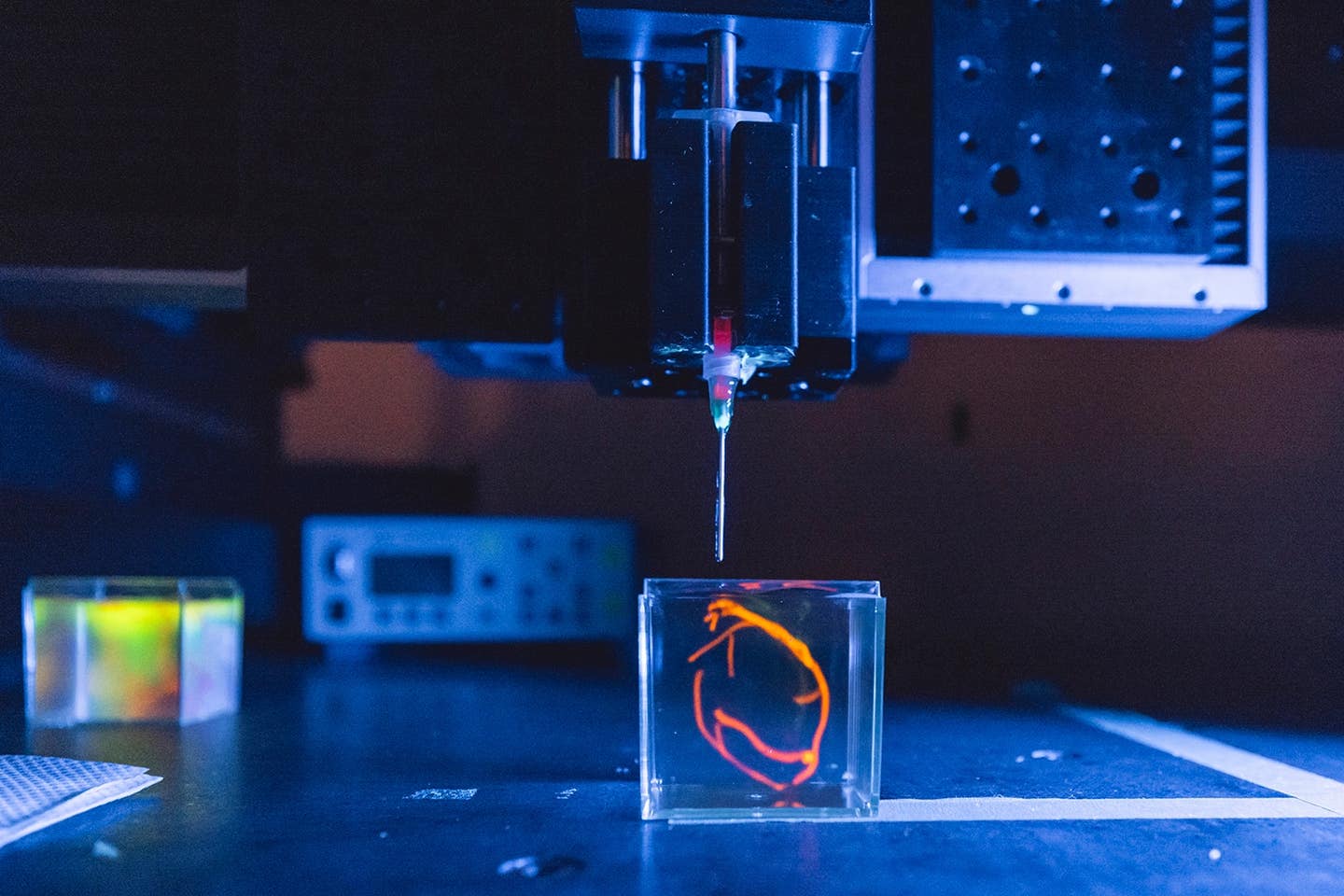Stanford researchers will 3D bioprint and implant a fully-functional human heart
It’s truly a moonshot effort, but the raw ingredients for bioprinting a complete and complex human organ are now in place for this big push

[Oct. 3, 2023: Staff Writer, The Brighter Side of News]
A 3D bioprinter in the Skylar-Scott lab prints a sample of heart tissue in 2022. (CREDIT: Andrew Brodhead)
A multidisciplinary team of researchers at Stanford University is taking direct aim at bioprinting a fully functioning human heart and implant it in a living pig within the next five years.
“It’s truly a moonshot effort, but the raw ingredients for bioprinting a complete and complex human organ are now in place for this big push,” said Mark Skylar-Scott, assistant professor of bioengineering in the Schools of Engineering and Medicine, a member of the Stanford Cardiovascular Institute, and principal investigator on the project.
The vision of fabricating bespoke, patient-specific human organs – livers, lungs, kidneys, brain, and, yes, a human heart – has been a tantalizing dream of modern medicine for years, but only recently has stem cell science, the scale of cell production, and 3D bioprinting advanced to a point where the dream is within reach.
Bioprinting is a 3D printing technology that, instead of using plastic or metal, prints living tissues cell by cell. The key development, Skylar-Scott said, is that we can now print cells and blood vessels into those tissues.
Related Stories
“With vasculature comes the ability to make large and thick tissues that can be implanted and survive,” Skylar-Scott said. “Thus begins the era of organ biofabrication.”
That bioprinting expertise is coupled with a dramatic leap in scale in cell production, from the petri dish of old to today’s reactors able to turn out heart-specific cells billions at a time. These will become the bioprinter’s “ink.”
“We are going to use an automated bank of bioreactors to produce the different cell types of the heart,” Skylar-Scott said.
This bank of bioreactors will turn out billions of ventricular and atrial cardiomyocytes, specialized conduction cells that form the Purkinje fibers, nodal cells that are the heart’s pace-making cells, as well as smooth muscle cells, macrophages that support tissue development, and, of course, the blood vessel endothelial cells needed to keep the tissue alive. Skylar-Scott estimates that the team will be able to generate sufficient cells for a heart every two weeks.
“We will use these vast numbers of cells to practice, practice, practice and learn all the design rules of the heart and optimize viability and function at the whole-heart scale for eventual implantation into a pig,” he said.
Mark Skylar-Scott, assistant professor of bioengineering in the Schools of Engineering and Medicine (CREDIT: Stanford University)
The bioprinted human heart will be transplanted into a pig with severe congenital immunodeficiency to prevent rejection. However, the team’s approach uses patient-specific stem cells that, when transplanted into that same patient, may not require immunosuppression. “Your own heart, made out of your own cells; that is the dream,” Skylar-Scott added.
The dramatic scope of the project prompts vision of a day when similar biofabrication plants manufacture new hearts, lungs, livers, and other organs for implantation into ailing humans – each bioprinted organ a perfect genetic match for its patient.
The team’s approach uses patient-specific stem cells that, when transplanted into that same patient, may not require immunosuppression. (CREDIT: Stanford University)
Such aspirations are to be expected, Skylar-Scott said, but he adds that he believes that day is still decades off, if not more. Still, this bioprinting initiative will serve as a necessary and powerful proof-of-concept to accelerate the commercialization and translation of organ engineering.
Ecosystem of expertise
Discussion of such possibilities brings Skylar-Scott full circle to the challenge ahead. Bioprinting and implanting a heart into a living creature will require a profound collection of expertise well beyond the skills of any one researcher. In that regard, Skylar-Scott returns to the Stanford research ecosystem that makes this project a possibility.
The Cardiovascular Institute, stem cell derivation expertise, and vascular experts to provide the raw materials combined with a great ecosystem of 3D bioprinting and materials faculty to think how to use and assemble the materials. (CREDIT: Stanford University)
While he is the principal investigator on the project, the full team of Stanford experts needed to make the dream a reality is remarkable in its depth and breadth. It includes experts in engineering, biochemistry, computer modeling, cardiology, cardiothoracic surgery, biology, materials science, and more. Only Stanford concentrates leadership in all these disparate but interrelated fields within walking distance of one another.
Stanford is a real center of excellence for cardiovascular medicine, Skylar-Scott said – the Cardiovascular Institute, stem cell derivation expertise, and vascular experts to provide the raw materials combined with a great ecosystem of 3D bioprinting and materials faculty to think how to use and assemble the materials.
“When you have all these resources in one place, it makes it easier to collaborate and to do some pretty amazing things,” Skylar-Scott said.
Note: Materials provided above by The Brighter Side of News. Content may be edited for style and length.
Like these kind of feel good stories? Get the Brighter Side of News' newsletter.
Joseph Shavit
Head Science News Writer | Communicating Innovation & Discovery
Based in Los Angeles, Joseph Shavit is an accomplished science journalist, head science news writer and co-founder at The Brighter Side of News, where he translates cutting-edge discoveries into compelling stories for a broad audience. With a strong background spanning science, business, product management, media leadership, and entrepreneurship, Joseph brings a unique perspective to science communication. His expertise allows him to uncover the intersection of technological advancements and market potential, shedding light on how groundbreaking research evolves into transformative products and industries.



